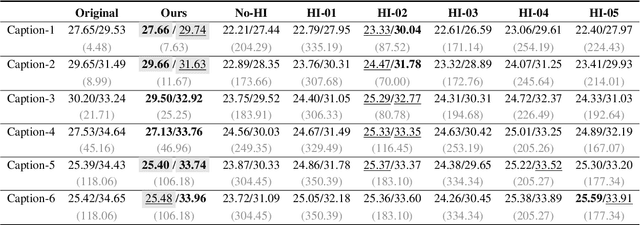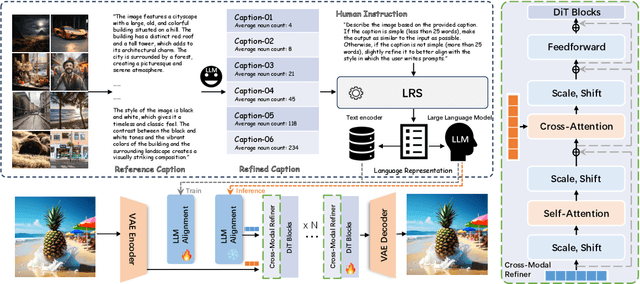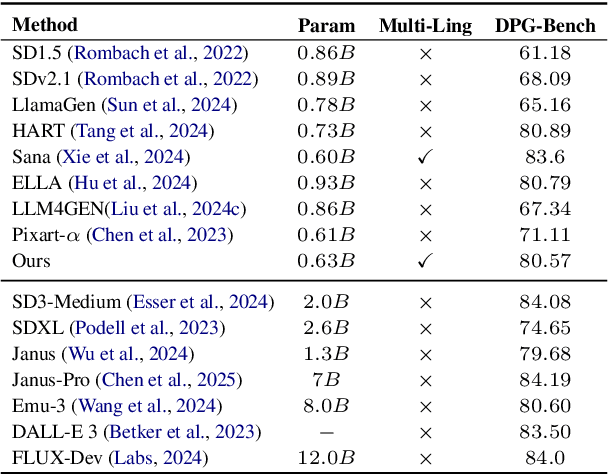Zide Liu
LDGen: Enhancing Text-to-Image Synthesis via Large Language Model-Driven Language Representation
Feb 25, 2025



Abstract:In this paper, we introduce LDGen, a novel method for integrating large language models (LLMs) into existing text-to-image diffusion models while minimizing computational demands. Traditional text encoders, such as CLIP and T5, exhibit limitations in multilingual processing, hindering image generation across diverse languages. We address these challenges by leveraging the advanced capabilities of LLMs. Our approach employs a language representation strategy that applies hierarchical caption optimization and human instruction techniques to derive precise semantic information,. Subsequently, we incorporate a lightweight adapter and a cross-modal refiner to facilitate efficient feature alignment and interaction between LLMs and image features. LDGen reduces training time and enables zero-shot multilingual image generation. Experimental results indicate that our method surpasses baseline models in both prompt adherence and image aesthetic quality, while seamlessly supporting multiple languages. Project page: https://zrealli.github.io/LDGen.
FreeCustom: Tuning-Free Customized Image Generation for Multi-Concept Composition
May 22, 2024



Abstract:Benefiting from large-scale pre-trained text-to-image (T2I) generative models, impressive progress has been achieved in customized image generation, which aims to generate user-specified concepts. Existing approaches have extensively focused on single-concept customization and still encounter challenges when it comes to complex scenarios that involve combining multiple concepts. These approaches often require retraining/fine-tuning using a few images, leading to time-consuming training processes and impeding their swift implementation. Furthermore, the reliance on multiple images to represent a singular concept increases the difficulty of customization. To this end, we propose FreeCustom, a novel tuning-free method to generate customized images of multi-concept composition based on reference concepts, using only one image per concept as input. Specifically, we introduce a new multi-reference self-attention (MRSA) mechanism and a weighted mask strategy that enables the generated image to access and focus more on the reference concepts. In addition, MRSA leverages our key finding that input concepts are better preserved when providing images with context interactions. Experiments show that our method's produced images are consistent with the given concepts and better aligned with the input text. Our method outperforms or performs on par with other training-based methods in terms of multi-concept composition and single-concept customization, but is simpler. Codes can be found at https://github.com/aim-uofa/FreeCustom.
Zero-Shot Video Editing Using Off-The-Shelf Image Diffusion Models
Apr 13, 2023



Abstract:Large-scale text-to-image diffusion models achieve unprecedented success in image generation and editing. However, how to extend such success to video editing is unclear. Recent initial attempts at video editing require significant text-to-video data and computation resources for training, which is often not accessible. In this work, we propose vid2vid-zero, a simple yet effective method for zero-shot video editing. Our vid2vid-zero leverages off-the-shelf image diffusion models, and doesn't require training on any video. At the core of our method is a null-text inversion module for text-to-video alignment, a cross-frame modeling module for temporal consistency, and a spatial regularization module for fidelity to the original video. Without any training, we leverage the dynamic nature of the attention mechanism to enable bi-directional temporal modeling at test time. Experiments and analyses show promising results in editing attributes, subjects, places, etc., in real-world videos. Code is made available at \url{https://github.com/baaivision/vid2vid-zero}.
 Add to Chrome
Add to Chrome Add to Firefox
Add to Firefox Add to Edge
Add to Edge